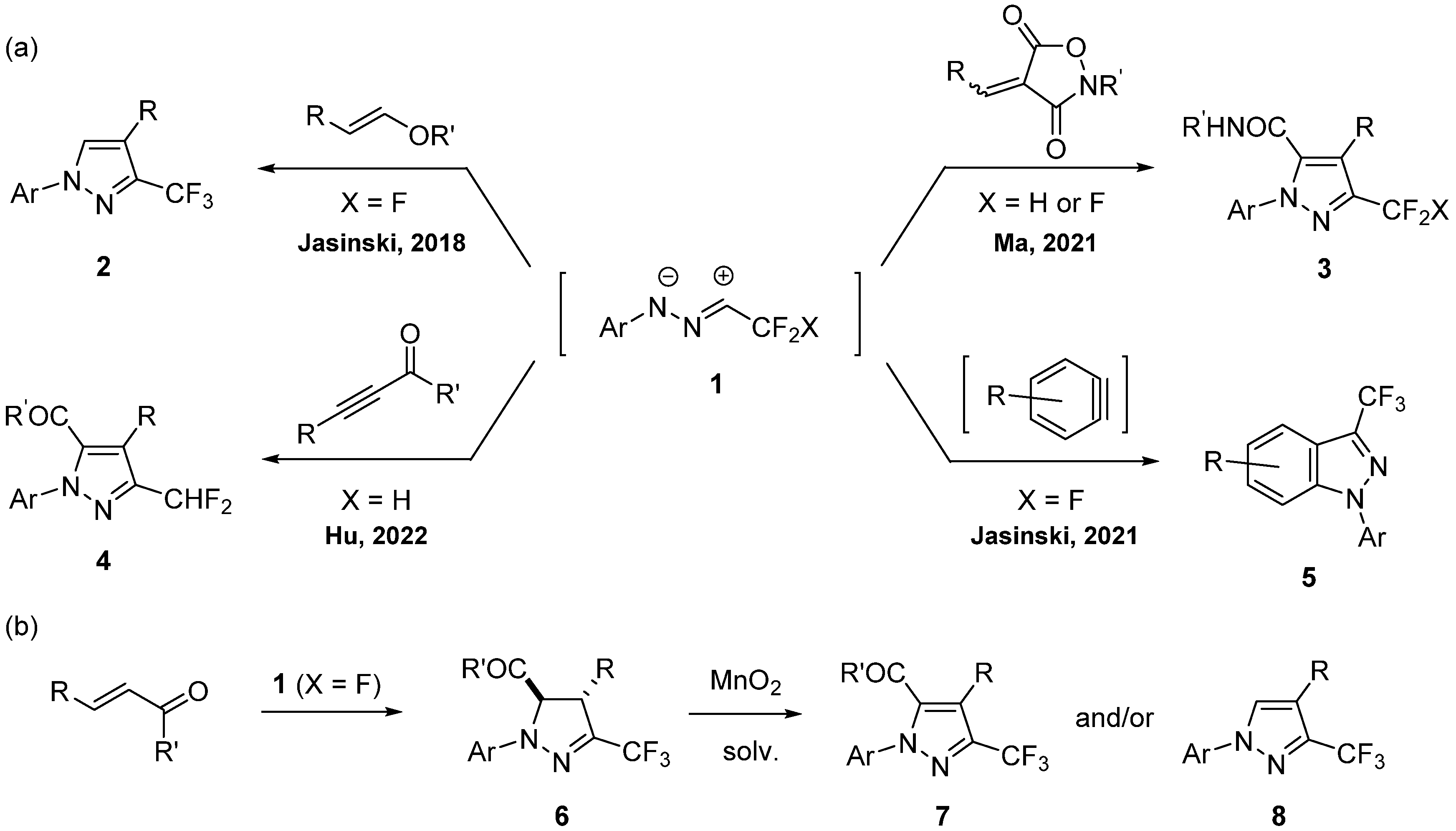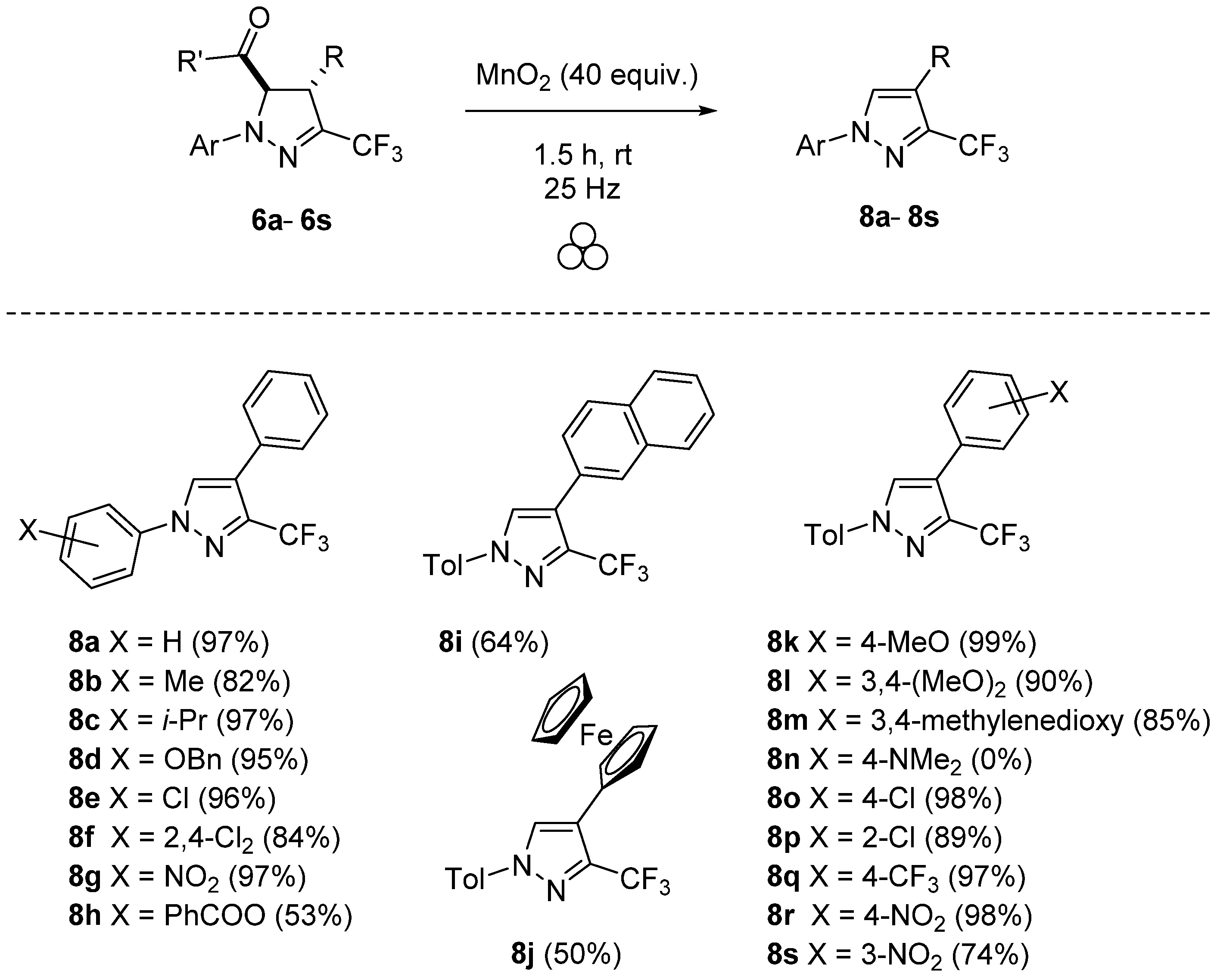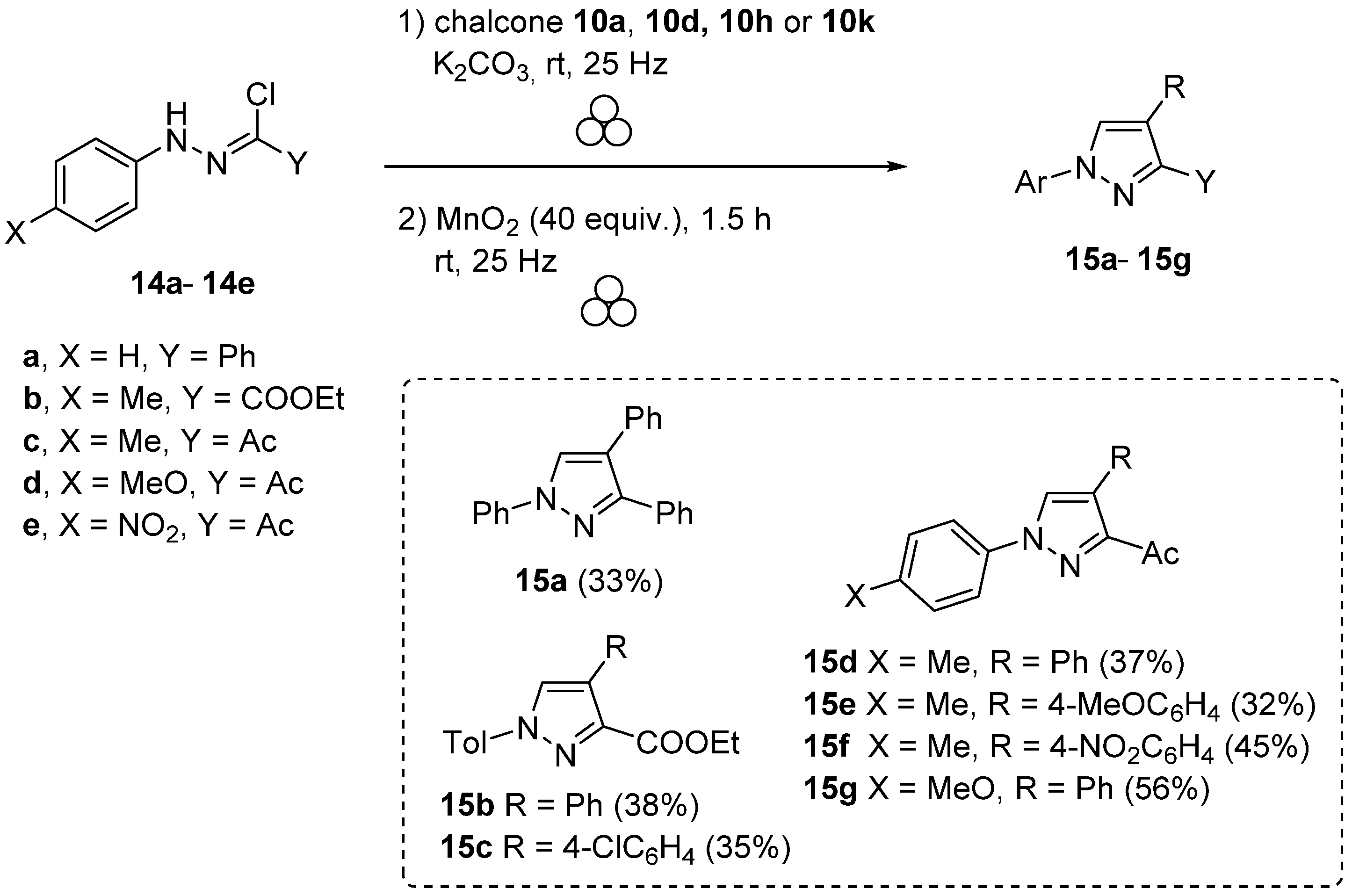Fluorinated and Non-Fluorinated 1,4-Diarylpyrazoles via MnO2-Mediated Mechanochemical Deacylative Oxidation of 5-Acylpyrazolines †
Abstract
1. Introduction
2. Results and Discussion
3. Materials and Methods
3.1. Chemical Synthesis General Methods
3.1.1. General Procedure for Mechanochemical Synthesis of Pyrazolines 6, 6′, and 13
3.1.2. General Procedure for Oxidation Reactions with Activated Manganese Dioxide
4. Conclusions
Supplementary Materials
Author Contributions
Funding
Data Availability Statement
Conflicts of Interest
References
- Fustero, S.; Sánchez-Roselló, M.; Barrio, P.; Simón-Fuentes, A. From 2000 to mid-2010: A fruitful decade for the synthesis of pyrazoles. Chem. Rev. 2011, 111, 6984–7034. [Google Scholar] [CrossRef] [PubMed]
- Mykhailiuk, P.K. Fluorinated pyrazoles: From synthesis to applications. Chem. Rev. 2021, 121, 1670–1715. [Google Scholar] [CrossRef] [PubMed]
- Raffa, D.; Maggio, B.; Raimondi, M.V.; Cascioferro, S.; Plescia, F.; Cancemi, G.; Daidone, G. Recent advanced in bioactive systems containing pyrazole fused with a five membered heterocycle. Eur. J. Med. Chem. 2015, 97, 732–746. [Google Scholar] [CrossRef]
- Janin, Y.L. Preparation and chemistry of 3/5-halogenopyrazoles. Chem. Rev. 2012, 112, 3924–3958. [Google Scholar] [CrossRef]
- Li, M.; Zhao, B.X. Progress of the synthesis of condensed pyrazole derivatives (from 2010 to mid-2013). Eur. J. Med. Chem. 2014, 85, 311–340. [Google Scholar] [CrossRef]
- Abrigach, F.; Touzani, R. Pyrazole derivatives with NCN junction and their biological activity: A review. Med. Chem. 2016, 6, 292–298. [Google Scholar] [CrossRef]
- Faria, J.V.; Vegi, P.F.; Miguita, A.G.C.; Silva dos Santos, M.; Boechat, N.; Bernardino, A.M.R. Recently reported biological activities of pyrazole compounds. Bioorg. Med. Chem. 2017, 25, 5891–5903. [Google Scholar] [CrossRef]
- Kumar, V.; Kaur, K.; Gupta, G.K.; Sharma, A.K. Pyrazole containing natural products: Synthetic preview and biological significance. Eur. J. Med. Chem. 2013, 69, 735–753. [Google Scholar] [CrossRef]
- El-Gamal, M.; Zaraei, S.-O.; Madkour, M.M.; Anbar, H.S. Evaluation of substituted pyrazole-based kinase inhibitors in one decade (2011–2020): Current status and future prospects. Molecules 2022, 27, 330. [Google Scholar] [CrossRef]
- Li, X.; Yu, Y.; Tu, Z. Pyrazole scaffold synthesis, functionalization, and applications in Alzheimer’s disease and Parkinson’s disease treatment (2011–2020). Molecules 2021, 26, 1202. [Google Scholar] [CrossRef]
- Asproni, B.; Murineddu, G.; Corona, P.; Pinna, G.A. Tricyclic pyrazole-based compounds as useful scaffolds for cannabinoid CB1/CB2 receptor interaction. Molecules 2021, 26, 2126. [Google Scholar] [CrossRef] [PubMed]
- Santos, N.E.; Carreira, A.R.F.; Silva, V.L.M.; Braga, S.S. Natural and biomimetic antitumor pyrazoles, a perspective. Molecules 2020, 25, 1364. [Google Scholar] [CrossRef] [PubMed]
- Gomes, P.M.O.; Silva, A.M.S.; Silva, V.L.M. Pyrazoles as key scaffolds for the development of fluorine-18-labeled radiotracers for positron emission tomography (PET). Molecules 2020, 25, 1722. [Google Scholar] [CrossRef] [PubMed]
- Elnagdy, H.M.F.; Chetia, T.; Dehingia, N.; Chetia, B.; Dutta, P.; Sarma, D. Sensing and optical activities of new pyrazole containing polymeric analogues. Bull. Mater. Sci. 2022, 45, 86. [Google Scholar] [CrossRef]
- Cavero, E.; Uriel, S.; Romero, P.; Serrano, J.L.; Giménez, R. Tetrahedral zinc complexes with liquid crystalline and luminescent properties: Interplay between nonconventional molecular shapes and supramolecular mesomorphic order. J. Am. Chem. Soc. 2007, 129, 11608–11618. [Google Scholar] [CrossRef] [PubMed]
- Trofimenko, S. Coordination chemistry of pyrazole-derived ligands. Chem. Rev. 1972, 72, 497–509. [Google Scholar] [CrossRef]
- Jamieson, C.; Livingstone, K. The Nitrile Imine 1,3-dipole; Properties, Reactivity and Applications; Springer Nature: Cham, Switzerland, 2020. [Google Scholar]
- Howard, J.L.; Cao, Q.; Browne, D.L. Mechanochemistry as an emerging tool for molecular synthesis: What can it offer? Chem. Sci. 2018, 9, 3080–3094. [Google Scholar] [CrossRef]
- Tan, D.; Garcia, F. Main group mechanochemistry: From curiosity to established protocols. Chem. Soc. Rev. 2019, 48, 2274–2292. [Google Scholar] [CrossRef]
- Pickhardt, W.; Grätz, S.; Borchardt, L. Direct mechanocatalysis: Using milling balls as catalysts. Chem. Eur. J. 2020, 26, 12903–12911. [Google Scholar] [CrossRef]
- Leonardi, M.; Villacampa, M.; Menéndez, J.C. Multicomponent mechanochemical synthesis. Chem. Sci. 2018, 9, 2042–2064. [Google Scholar] [CrossRef]
- Pérez-Venegas, M.; Juaristi, E. Mechanochemical and mechanoenzymatic synthesis of pharmacologically active compounds: A green perspective. ACS Sustain. Chem. Eng. 2020, 8, 8881–8893. [Google Scholar] [CrossRef]
- Porcheddu, A.; Delogu, F.; De Luca, L.; Colacino, E. From lossen transposition to solventless “Medicinal Mechanochemistry”. ACS Sustain. Chem. Eng. 2019, 7, 12044–12051. [Google Scholar] [CrossRef]
- Yu, J.; Hong, Z.; Yang, X.; Jiang, Y.; Jiang, Z.; Su, W. Bromide-assisted chemoselective Heck reaction of 3-bromoindazoles under high-speed ball-milling conditions: Synthesis of axitinib. Beilstein J. Org. Chem. 2018, 14, 786–795. [Google Scholar] [CrossRef]
- El-Sayed, T.; Aboelnaga, A.; El-Atawy, M.A.; Hagar, M. Ball milling promoted N-heterocycles synthesis. Molecules 2018, 23, 1348. [Google Scholar] [CrossRef]
- Singh, P.; Nath, M. A concise account on eco-friendly synthetic strategies for pyrazole heterocycles. Curr. Green Chem. 2019, 6, 198–209. [Google Scholar] [CrossRef]
- Saeed, A.; Channar, P.A. A green mechanochemical synthesis of new 3,5-dimethyl-4-(arylsulfanyl)pyrazoles. J. Heterocycl. Chem. 2017, 54, 780–783. [Google Scholar] [CrossRef]
- Chowhan, B.; Kour, J.; Gupta, M.; Paul, S. Green synthesis of bis(pyrazol-5-ole) and pyrazolopyranopyrimidine derivatives through mechanochemistry using chitosan as a biodegradable catalyst. ChemistrySelect 2021, 6, 7922–7930. [Google Scholar] [CrossRef]
- Gomes, P.M.O.; Ouro, P.M.S.; Silva, A.M.S.; Silva, V.L.M. Styrylpyrazoles: Properties, synthesis and transformations. Molecules 2020, 25, 5886. [Google Scholar] [CrossRef]
- Howard, J.L.; Nicholson, W.; Sagatov, Y.; Browne, D.L. One-pot multistep mechanochemical synthesis of fluorinated pyrazolone. Beilstein J. Org. Chem. 2017, 13, 1950–1956. [Google Scholar] [CrossRef]
- Zhang, Z.; Tan, Y.-J.; Wang, C.-S.; Wu, H.-H. One-pot synthesis of 3,5-diphenyl-1H-pyrazoles from chalcones and hydrazine under mechanochemical ball milling. Heterocycles 2014, 89, 103–112. [Google Scholar] [CrossRef]
- Paveglio, G.C.; Longhi, K.; Moreira, D.N.; München, T.S.; Tier, A.Z.; Gindri, I.M.; Bender, C.R.; Frizzo, C.P.; Zanatta, N.; Bonacorso, H.G.; et al. How mechanical and chemical features affect the green synthesis o 1H-pyrazoles in a ball mill. ACS Sustain. Chem. Eng. 2014, 2, 1895–1901. [Google Scholar] [CrossRef]
- Oh, L.M. Synthesis of celecoxib via 1,3-dipolar cycloaddition. Tetrahedron Lett. 2006, 47, 7943–7946. [Google Scholar] [CrossRef]
- Utecht, G.; Fruziński, A.; Jasiński, M. Polysubstituted 3-trifluoromethylpyrazoles: Regioselective (3+2)-cycloaddition of trifluoroacetonitrile imines with enol ethers and functional group transformations. Org. Biomol. Chem. 2018, 16, 1252–1257. [Google Scholar] [CrossRef] [PubMed]
- Utecht, G.; Mlostoń, G.; Jasiński, M. A straightforward access to trifluoromethylated spirobipyrazolines through a double (3+2)-cycloaddition of fluorinated nitrile imines with alkoxyallenes. Synlett 2018, 29, 1753–1758. [Google Scholar] [CrossRef]
- Kowalczyk, A.; Utecht-Jarzyńska, G.; Mlostoń, G.; Jasiński, M. A straightforward access to 3-trifluoromethyl-1H-indazoles via (3+2)-cycloaddition of arynes with nitrile imines derived from trifluoroacetonitrile. J. Fluorine Chem. 2021, 241, 109691. [Google Scholar] [CrossRef]
- Wang, K.-H.; Liu, H.; Liu, X.; Bian, C.; Wang, J.; Su, Y.; Huang, D.; Hu, Y. Regioselective synthesis of 3-trifluoromethyl 4-subtituted pyrazoles by [3+2]-cycloaddition of trifluoroacetonitrile imines and nitroalkenes. Asian J. Org. Chem. 2022, 11, e202200103-10. [Google Scholar] [CrossRef]
- Zhou, Y.; Gao, C.-F.; Ma, H.; Nie, J.; Ma, J.-A.; Zhang, F.-G. Quadruple functionalized pyrazole pharmacophores by one-pot regioselective [3+2]-cycloaddition of fluorinated nitrile imines and dicyanoalkenes. Chem Asian J. 2022, 17, e202200436. [Google Scholar] [CrossRef]
- Tian, Y.-C.; Li, J.-K.; Zhang, F.-G.; Ma, J.-A. Regioselective decarboxylative cycloaddition route to fully substituted 3-CF3-pyrazoles from nitrilimines and isoxazolidinediones. Adv. Synth. Catal. 2021, 363, 2093–2097. [Google Scholar] [CrossRef]
- Utecht-Jarzyńska, G.; Nagła, K.; Mlostoń, G.; Heimgartner, H.; Palusiak, M.; Jasiński, M. A straightforward conversion of 1,4-quinones into polycyclic pyrazoles via [3+2]-cycloaddition with fluorinated nitrile imines. Beilstein J. Org. Chem. 2021, 17, 1509–1517. [Google Scholar] [CrossRef]
- Han, T.; Wang, K.-H.; Yang, M.; Zhao, P.; Wang, F.; Wang, J.; Huang, D.; Hu, Y. Synthesis of difluoromethylated pyrazoles by the [3+2]-cycloaddition reaction of difluoroacetohydrazonoyl bromides. J. Org. Chem. 2022, 87, 498–511. [Google Scholar] [CrossRef]
- Kowalczyk, A.; Utecht-Jarzyńska, G.; Mlostoń, G.; Jasiński, M. Trifluoromethylated pyrazoles via sequential (3+2)-cycloaddition of fluorinated nitrile imines with chalcones and solvent-dependent deacylative oxidation reactions. Org. Lett. 2022, 24, 2499–2503. [Google Scholar] [CrossRef] [PubMed]
- Mlostoń, G.; Urbaniak, K.; Utecht, G.; Lentz, D.; Jasiński, M. Trifluoromethylated 2,3-dihydro-1,3,4-thiadiazoles via the regioselective [3+2]-cycloadditions of fluorinated nitrile imines with aryl, hetaryl, and ferrocenyl thioketones. J. Fluorine Chem. 2016, 192, 147–154. [Google Scholar] [CrossRef]
- Al-Hussain, S.A.; Alshehrei, F.; Zaki, M.E.A.; Harras, M.F.; Farghaly, T.A.; Muhammad, Z.A. Fluorinated hydrazonoyl chlorides as precursors for synthesis of antimicrobial azoles. J. Heterocyclic Chem. 2021, 58, 589–602. [Google Scholar] [CrossRef]
- Du, S.; Yang, Z.; Tang, J.; Chen, Z.; Wu, X.-F. Synthesis of 3H-1,2,4-triazol-3-ones via NiCl2-promoted cascade annulation of hydrazonoyl chlorides and sodium cyanate. Org. Lett. 2021, 23, 2359–2363. [Google Scholar] [CrossRef] [PubMed]
- Wojciechowska, A.; Jasiński, M.; Kaszyński, P. Tautomeric equilibrium in trifluoroacetaldehyde arylhydrazones. Tetrahedron 2015, 71, 2349–2356. [Google Scholar] [CrossRef]
- Shawali, A.S.; Ezmirly, S.T.; Bukhari, A.M. Nuclear magnetic resonance spectroscopy and the structures of the regioisomeric products of the cycloaddition of C-ethoxycarbonyl-N-arylnitrilimines to α,β-unsaturated ketones. Spectrochim. Acta Part A 1992, 48, 1165–1171. [Google Scholar] [CrossRef]
- Ortega-Martínez, A.; Molina, C.; Moreno-Cabrerizo, C.; Sansano, J.M.; Nájera, C. Deacylative reactions: Synthetic applications. Eur. J. Org. Chem. 2018, 2394–2405. [Google Scholar] [CrossRef]
- Fatiadi, A.J. Active manganese dioxide oxidation in organic chemistry—Part I. Synthesis 1976, 1976, 65–104. [Google Scholar] [CrossRef]
- Xie, H.; Zhu, J.; Chen, Z.; Li, S.; Wu, Y. Reaction of a trifluoromethylated N-monosubstituted hydrazone with α,β-ethenyl ketones: A novel synthesis of substituted pyrazolidines and pyrazolines. Synthesis 2011, 17, 2767–2774. [Google Scholar] [CrossRef]
- Grzelak, P.; Utecht, G.; Jasiński, M.; Mlostoń, G. First (3+2)-cycloadditions of thiochalcones as C=S dipolarophiles: Efficient synthesis of 1,3,4-thiadiazoles via reactions with fluorinated nitrile imines. Synthesis 2017, 49, 2129–2137. [Google Scholar] [CrossRef]
- Shi, C.; Ma, C.; Ma, H.; Zhou, X.; Cao, J.; Fan, Y.; Huang, G. Copper-catalyzed synthesis of 1,3,4-trisubstituted and 1,3,4,5-tetrasubstituted pyrazoles via [3+2] cycloadditions of hydrazones and nitroolefins. Tetrahedron 2016, 72, 4055–4058. [Google Scholar] [CrossRef]
- Castillo, J.-C.; Portilla, J. Recent advances in the synthesis of new pyrazole derivatives. In Targets in Heterocyclic Systems; Italian Society of Chemistry: Rome, Italy, 2018; Chapter 9; pp. 194–223. [Google Scholar] [CrossRef]
- Yet, L. Five-membered ring systems: With more than one N atom (chapter 5.4). In Progress in Heterocyclic Chemistry; Elsevier: Amsterdam, The Netherlands, 2020; Volume 31, pp. 325–361. [Google Scholar] [CrossRef]
- Ríos, M.-C.; Portilla, J. Recent advances in synthesis and properties of pyrazoles. Chemistry 2022, 4, 940–968. [Google Scholar] [CrossRef]
- Deepthi, A.; Acharjee, N.; Sruthi, S.L.; Meenakshy, C.B. An overview of nitrile imine based [3+2]-cycloadditions over half a decade. Tetrahedron 2022, 116, 132812. [Google Scholar] [CrossRef]
- Utecht-Jarzyńska, G.; Michalak, A.; Banaś, J.; Mlostoń, G.; Jasiński, M. Trapping of trifluoroacetonitrile imines with mercaptoacetaldehyde and mercaptocarboxylic acids: An access to fluorinated 1,3,4-thiadiazine derivatives via (3+3)-annulation. J. Fluorine Chem. 2019, 222−223, 8–14. [Google Scholar] [CrossRef]
- Zhang, Y.; Zeng, J.-L.; Chen, Z.; Wang, R. Base-promoted (3+2)-cycloaddition of trifluoroacetohydrazonoyl chlorides with imidates en route to trifluoromethyl-1,2,4-triazoles. J. Org. Chem. 2022, 87, 14514–14522. [Google Scholar] [CrossRef]
- Ren, Y.; Ma, R.; Feng, Y.; Wang, K.-H.; Wang, J.; Huang, D.; Lv, X.; Hu, Y. Sythesis of difluoroemthyl pyrazolines and pyrazoles by [3+2] cycloaddition reaction of difluoroacetohydrazonoyl bromides with electron-deficient olefins. Asian J. Org. Chem. 2022, 11, e202200438. [Google Scholar] [CrossRef]









| Entry | Base | 9a:10a:Base (Ratio) | Time (min) | Vjar (mL) | Conversion 1 (%) | Ratio (%) 1 (Isolated Yield) | |
|---|---|---|---|---|---|---|---|
| 6a | 6′a | ||||||
| 1 | Et3N | 1.1:1.0:1.2 | 60 | 1.5 | 56 2 | 87 | 13 |
| 2 | CsF | 1.1:1.0:1.2 | 60 | 1.5 | 27 2 | 72 | 28 |
| 3 | KF | 1.1:1.0:1.2 | 60 | 1.5 | 60 2 | 84 | 16 |
| 4 | Cs2CO3 | 1.1:1.0:1.2 | 60 | 1.5 | 45 2 | 79 | 21 |
| 5 | K2CO3 | 1.1:1.0:1.2 | 60 | 1.5 | 82 | 81 | 19 |
| 6 | K2CO3 | 1.1:1.0:1.2 | 90 | 1.5 | 84 | 82 | 18 |
| 7 | K2CO3 | 1.2:1.0:1.3 | 90 | 5 | 93 | 80 (73) | 20 (13) |
| 8 | K2CO3 | 1.2:1.0:1.3 | 180 | 5 | 93 | 82 (75) | 18 (13) |
| Entry | Substrate | X | 6:6′ Ratio 1 | Yield of 6 (%) 2 |
|---|---|---|---|---|
| 1 | 9b | 4-Me | 81:19 | 6b (70) |
| 2 | 9c | 4-i-Pr | 81:19 | 6c (71) |
| 3 | 9d | 4-OBn | 83:17 | 6d (58) |
| 4 | 9e | 4-Cl | 81:19 | 6e (53) |
| 5 | 9f | 2,4-Cl2 | 77:23 | 6f (54) |
| 6 | 9g | 4-NO2 | 74:26 | 6g (10) |
| 7 3 | 9g | 4-NO2 | 79:21 | 6g (22) |
| 8 3 | 9h | 4-PhCOO | 79:21 | 6h (17) |
| Entry | Substrate | R | R’ | Milling Time (h) | 6:6′ Ratio (%) 1 | Yield of 6 (%) 2 |
|---|---|---|---|---|---|---|
| 1 | 10b | 2-Nph 3 | Ph | 9 | 77:23 | 6i (74) |
| 2 | 10c | Fc 3 | Ph | 24 | 85:15 | 6j (38) |
| 3 | 10d | 4-MeOC6H4 | Ph | 20 | 76:24 | 6k (59) |
| 4 | 10e | 3,4-(MeO)2C6H3 | Ph | 18 | 100:0 | 6l (74) |
| 5 | 10f | 3,4-methylenedioxyphenyl | Ph | 12 | 88:12 | 6m (68) |
| 6 | 10g | 4-(Me2N)C6H4 | Ph | 36 | 65:35 | 6n (46) |
| 7 | 10h | 4-ClC6H4 | Ph | 9 | 79:21 | 6o (70) |
| 8 | 10i | 2-ClC6H4 | Ph | 10 | 77:23 | 6p (57) |
| 9 | 10j | 4-CF3C6H4 | Ph | 9 | 71:29 | 6q (28) |
| 10 | 10k | 4-NO2C6H4 | Ph | 28 | 73:27 | 6r (26) |
| 11 | 10l | 3-NO2C6H4 | Ph | 72 | 79:21 | 6s (65) |
| 12 | 10m | Ph | Fc 3 | 24 | 71:29 | 6t (39) |
| 13 | 10n | Ph | 4-BrC6H4 | 16 | 85:15 | 6u (68) |
| 14 | 10o | Ph | 3,4-methylenedioxyphenyl | 20 | 82:18 | 6v (81) |
Publisher’s Note: MDPI stays neutral with regard to jurisdictional claims in published maps and institutional affiliations. |
© 2022 by the authors. Licensee MDPI, Basel, Switzerland. This article is an open access article distributed under the terms and conditions of the Creative Commons Attribution (CC BY) license (https://creativecommons.org/licenses/by/4.0/).
Share and Cite
Utecht-Jarzyńska, G.; Kowalczyk, A.; Jasiński, M. Fluorinated and Non-Fluorinated 1,4-Diarylpyrazoles via MnO2-Mediated Mechanochemical Deacylative Oxidation of 5-Acylpyrazolines. Molecules 2022, 27, 8446. https://doi.org/10.3390/molecules27238446
Utecht-Jarzyńska G, Kowalczyk A, Jasiński M. Fluorinated and Non-Fluorinated 1,4-Diarylpyrazoles via MnO2-Mediated Mechanochemical Deacylative Oxidation of 5-Acylpyrazolines. Molecules. 2022; 27(23):8446. https://doi.org/10.3390/molecules27238446
Chicago/Turabian StyleUtecht-Jarzyńska, Greta, Anna Kowalczyk, and Marcin Jasiński. 2022. "Fluorinated and Non-Fluorinated 1,4-Diarylpyrazoles via MnO2-Mediated Mechanochemical Deacylative Oxidation of 5-Acylpyrazolines" Molecules 27, no. 23: 8446. https://doi.org/10.3390/molecules27238446
APA StyleUtecht-Jarzyńska, G., Kowalczyk, A., & Jasiński, M. (2022). Fluorinated and Non-Fluorinated 1,4-Diarylpyrazoles via MnO2-Mediated Mechanochemical Deacylative Oxidation of 5-Acylpyrazolines. Molecules, 27(23), 8446. https://doi.org/10.3390/molecules27238446








